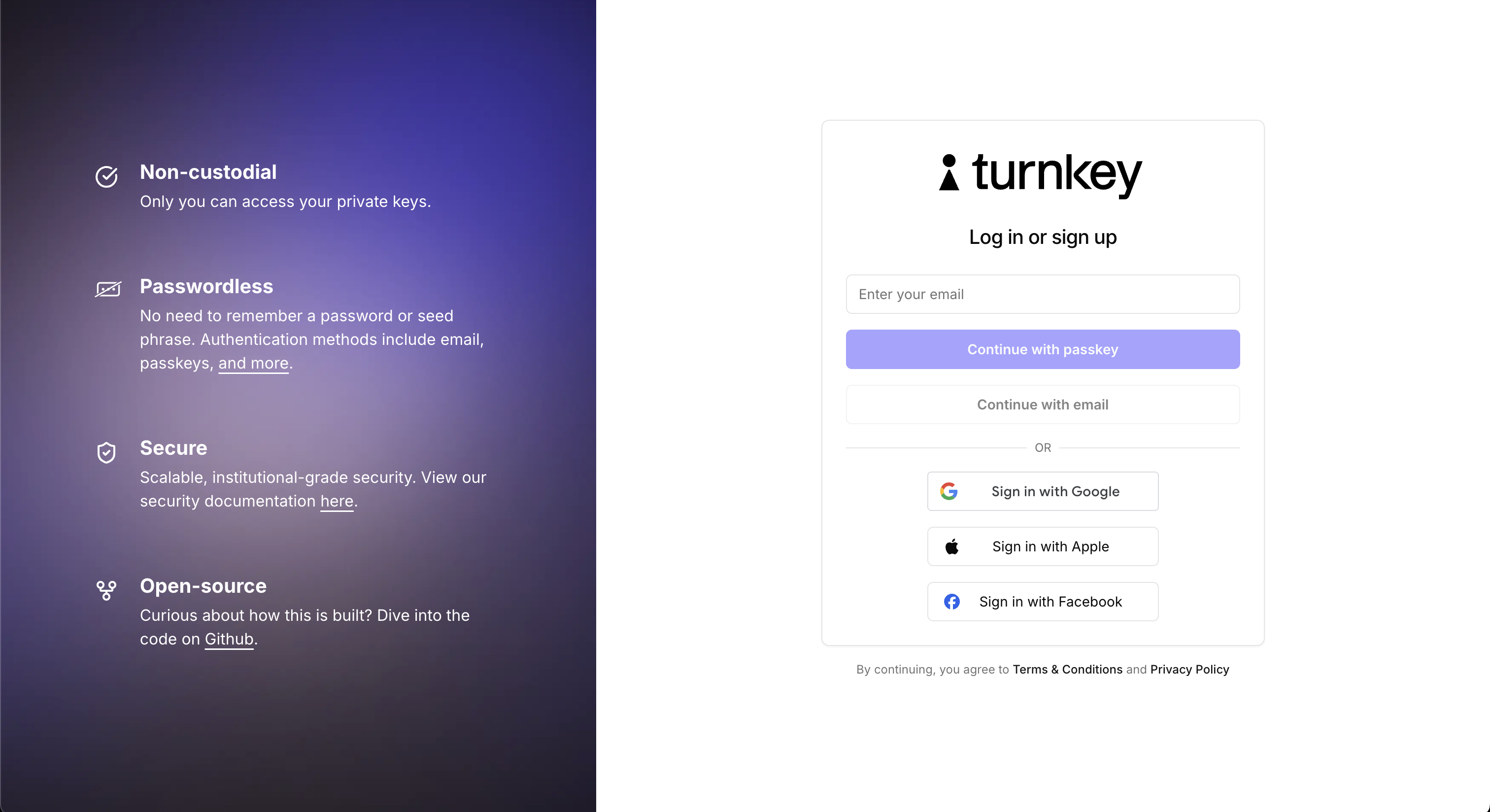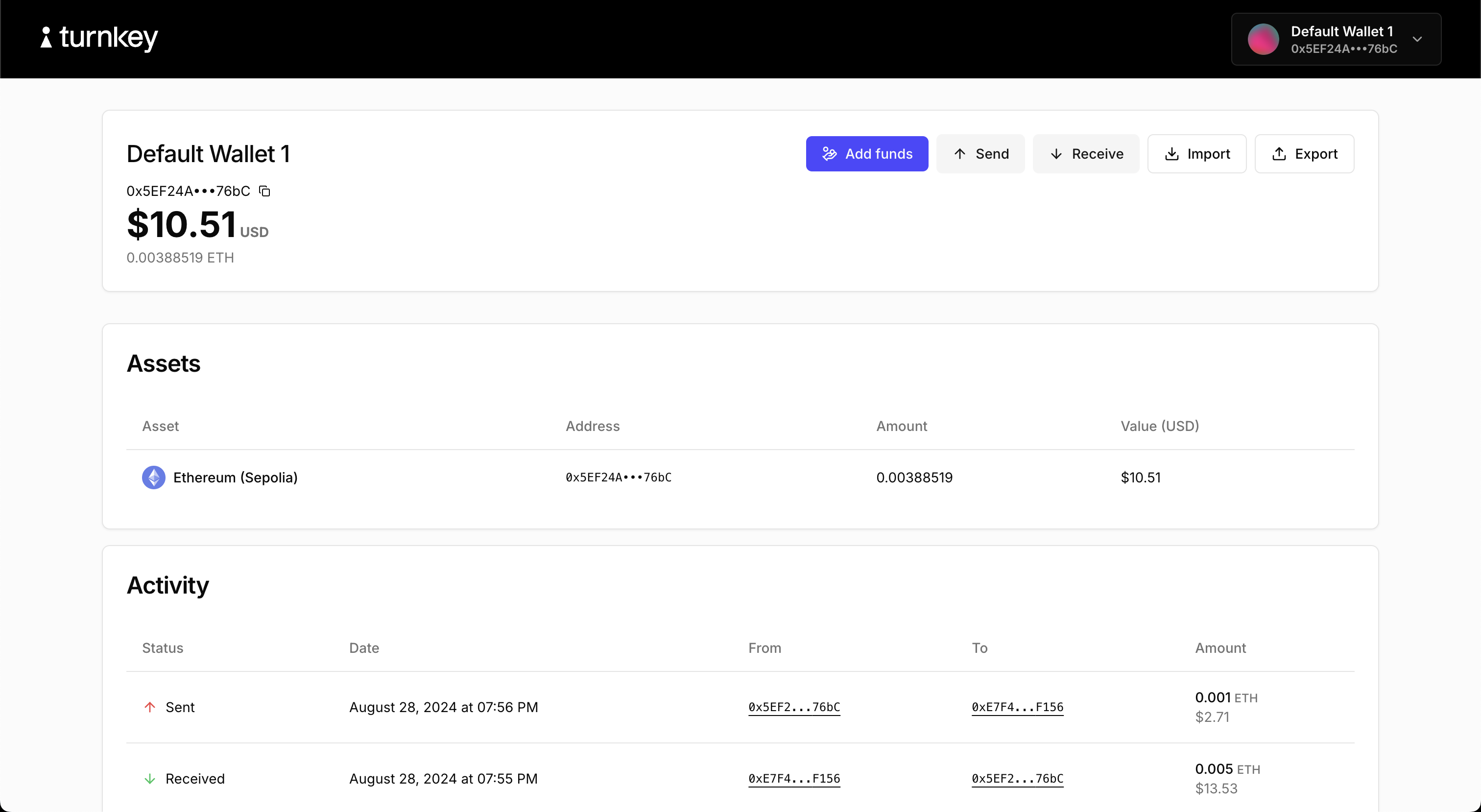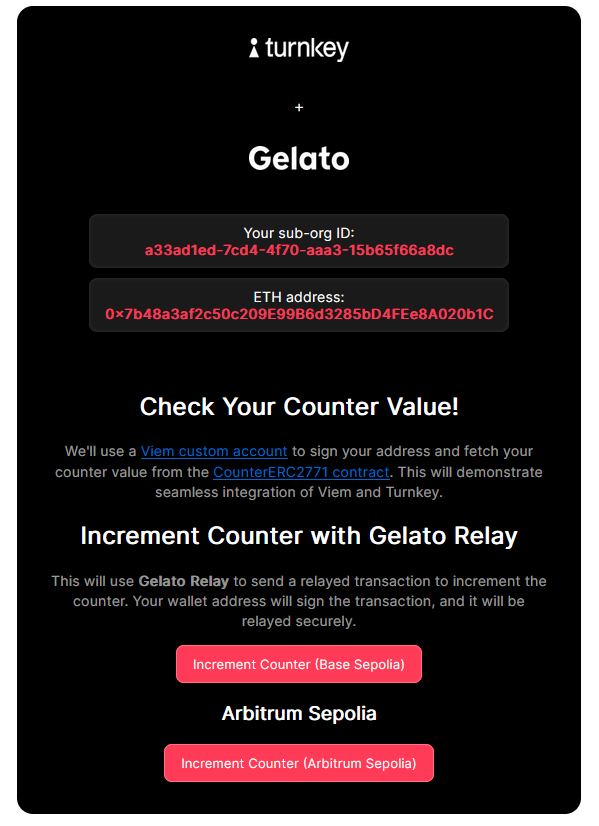Skip to main contentWith Embedded Wallets, you can create custom wallet experiences that are seamlessly integrated into your product, without compromising on security. Whether you need custodial or non-custodial wallets, our infrastructure provides the foundation for building innovative, user-friendly crypto products.
Why Embedded Wallets?
Embedded Wallets give you the freedom to design and control the entire user experience, while offloading the complexity and risk of private key management to Turnkey.
With Embedded Wallets, you can:
- Leverage pre-built UI components to speed up your integration
- Easily create a variety of wallets for your users
- Authenticate users via email, phone number, biometrics, social logins, etc
- Determine delegated access and co-owernership controls
- Access out-of-the-box support for multiple chains and assets
- Sign multiple transactions without additional approvals
- Access simple integrations for gas sponsorship and smart contract wallets
Custodial vs non-custodial
Turnkey’s Embedded Wallets are built on top of Sub-Organizations.
Each wallet is represented by a sub-organization, which can be configured with different security settings and access controls.
- For custodial wallets, your application holds the master key and can initiate transactions on behalf of users.
- For non-custodial wallets, users hold their own private keys and must approve each transaction,
using one of their configured authentication methods.
Below, we’ll dive into how we set each of these up but first, let’s make sure you’re familiar with
the Embedded Wallets concepts and architecture.
Embedded Wallets Quickstart
Head over to the Getting Started guide to set up your React app with @turnkey/react-wallet-kit.
Looking for more support? Check out our Demos, SDKs and Code Examples below!
Demos
Demo Embedded Wallet (code)
A comprehensive demo showcasing how to build an embedded wallet using Turnkey. This demo uses the @turnkey/sdk-browser, @turnkey/sdk-react and @turnkey/sdk-server packages and includes features such as:
- User authentication with passkeys, email auth, and OAuth
- Creating new wallets and wallet accounts
- Sending and receiving funds
- Importing/Exporting a wallet
- Adding a credential to the wallet
See https://github.com/tkhq/demo-embedded-wallet for the code.
Demo Consumer Wallet (code)
A minimal consumer wallet app powered by Turnkey. Behind the scenes, it uses @turnkey/ethers for signing and WalletConnect (v1) for accessing dapps.
See https://github.com/tkhq/demo-consumer-wallet for the code.
A wallet application showing how users can register and authenticate using passkeys. This demo uses the Turnkey API to create a new Turnkey Sub-Organization for each user, create a testnet Ethereum address and send a transaction on Sepolia (ETH testnet).
See https://wallet.tx.xyz (and https://github.com/tkhq/demo-embedded-wallet for the code).
Demo Ethers Passkeys (code)
A simple application demonstrating how to create sub-organizations, create private keys, and sign with the @turnkey/ethers signer, using passkeys.
See https://github.com/tkhq/demo-ethers-passkeys for the code.
Demo Viem Passkeys (code)
A similar, simple application demonstrating how to create sub-organizations, create private keys, and sign with the @turnkey/viem signer, using passkeys.
See https://github.com/tkhq/demo-viem-passkeys for the code.
Demo Viem Passkeys with Gelato Relay (code)
This example demonstrates how to leverage Turnkey’s secure key management and Gelato’s battle-tested relay infrastructure to enable seamless, sponsored interactions with meta-transactions using the @turnkey/viem signer and @gelatonetwork/relay-sdk-viem.
How Infinex Leverages Turnkey and Gelato
Infinex, a platform designed to unify the decentralized ecosystem and applications under a single UX layer, eliminates the complexities of navigating fragmented crypto protocols. By integrating Turnkey and Gelato, Infinex delivers a seamless, secure, and cost-efficient experience for decentralized finance users.
-
Secure Key Management with Turnkey: Infinex ensures private keys are securely managed within Turnkey’s infrastructure, removing the need for traditional wallet pop-ups. This approach streamlines authentication through passkeys, offering a frictionless and secure user experience.
-
Gasless Transactions with Gelato: Leveraging Gelato’s Relay (ERC-2771), Infinex enables fully sponsored transactions, allowing users to interact with decentralized applications without ever paying gas fees. This enhances accessibility and usability, ensuring that users can participate without holding or managing native blockchain tokens for fees.
The synergy between Turnkey and Gelato allows Infinex to offer an intuitive, cost-free user experience while maintaining the highest standards of security and scalability.
React Native Demo App (code)
A React Native app that demonstrates how to use the Turnkey’s JavaScript packages in a mobile environment to authenticate users, create wallets, export wallets, sign messages, and more
See https://github.com/tkhq/react-native-demo-wallet
for the code.
Flutter Demo App (code)
A Flutter app that demonstrates how to use the Turnkey’s Flutter packages to authenticate users, create wallets, export wallets, sign messages, and more
See https://github.com/tkhq/dart-sdk/tree/main/examples/flutter-demo-app
for the code
SDKs
Next Steps
Learn more about our powerful features here. 




